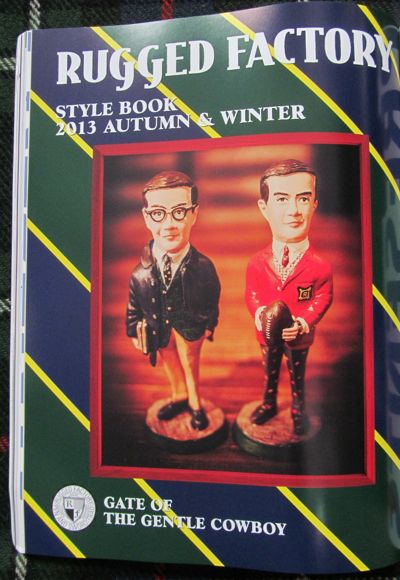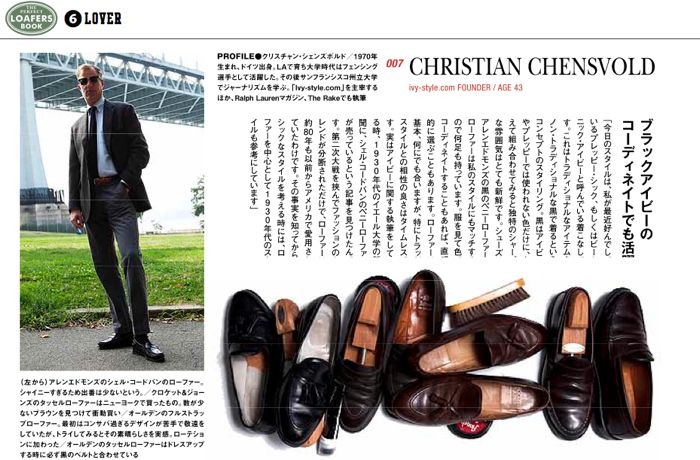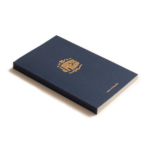The latest issue of Japanese magazine Free & Easy is called “The Updated Ivy” issue and features scads of pages of every imaginable wacky twist on trad classics. In fact, one passage explicitly states that Tokyo Ivy is a lot “crazier” than New York Ivy.
What do they mean by crazy? Well for starters there’s a ton of paneled pieces in the magazine: shirts, sweaters, and sportcoats:
This one is tweed but in oxfordish colors. Very clever:
The cover story attempts to trace the history of Ivy (starting at midcentury, not earlier) and how it became “rugged Ivy,” according to my translator.
Of course, “rugged Ivy” is a Japanese construct, rather like the English with their concept of Ivy that includes French New Wave films, modern architecture, jazz, Zippo lighters, scooters, and other generic totems of midcentury Americana.
But one has to admire both countries for importing the basic concept and then making it their own. After all, that’s what America did with the Ivy League Look, since most of the ingredients are English but made and worn in an American way.
The opening spread in the magazine (after the inside front cover) is a for the MFIT’s “Ivy Style” exhibit, which is being brought over by the Isetan department store and opens later this month. Our man in Tokyo W. David Marx says he should be able to attend opening festivities and file a report.
Later there’s a big story:
I liked this page, with the rep background, bobblehead-like figures, and puzzling language:
Finally, the magazine came over for two photo shoots last month. For the first, I was included in a big loafers piece that features a bunch of guys and their shoes. I like the fact that I’m guy #007, though my pose was actually inspired by AEV:
The second shoot was a lot more fun as I got to help create it. That’s my clothes and stuff, shot in my living room. The ties (it’s an ad for a tie company) were Photoshopped in later. — CC


















I will say that those bobbleheads are cool. Christian, can you point me in the right direction?
It’s interesting how much the Japanese have appreciated American Trad. Arguably, they’re bigger enthusiasts than the US currently is.
I wouldn’t wear the patchwork items myself, but their appropriation and interpretation will ensure the global survival of our style. That’s pretty cool.
Christian, please can you learn the difference between British and English, our Celtic cousins have been known, understandably, to be a bit touchy about such things!
English Ivy (LOL) is English, right? Or are there Ivy enthusiasts in Wales, Scotland and/or Ulster?
Classic & Traditional American style is popular all over the world.
Not just Japan, Great Britain & Ireland also Continental Europe and Australasia too.
I’d also like info on those bobbleheads. And that patchwork tweed jacket would be fresh if it was linen. Those look more like summer colors to me.
No info on the non-bobbling bobbleheads. I did ask the girlfriend to look for stuff like that from VAN Jac when she was last in Tokyo, but she couldn’t find any. I’m sure it’s there somewhere.
The last picture is fantastic!!!
@OCBD
These folks can custom make whomever, dressed as whatever you want. http://www.bobbleheads.com/
Taliesin, I’m pointing out that Christian, not for the fisrt time, states that “since most of the ingredients are English”. As much as I’d like to claim the essential Ivy ingredients for my country, it simply isn’t true. It’s like calling an American a Canadian.
@Harry Palmer
If we Americans choose to use the word “English” to mean “British”, it’s
simply an example of lexical variation between your English and ours. American English is our native language, and it’s really not up to others to tell us how to use it.
Apart from that, the fact remains that blazers, regimental stripe neckties, oxford cloth, grey flannel trousers, are in fact English. Tweeds may be the only item that you might argue are British, rather than English. But, in fact, we borrowed them from the attire of English country gentleman, not from the Scots.
Sorry.
That should have been “gentlemen”, rather than “gentleman”, of course.
Curmudgeon, English and British are different no matter what language you speak and if you choose to use it as the same thing you are simply wrong regardless of your nationality.
As you may or may not know England is part of the United Kingdom of Great Britain and Northern Ireland. There are four countries that make up the UK and only one of them is England.
In fairness it’s not only Americans that make this mistake, you only have to watch the Discovery Channel to see old German soldiers describing how they fought the English. In fact they were fighting the people of the British Commonwealth and Empire along with our allies.
American English is a dialect not a language. The fact that England is England is geographical fact not up for discussion.
IIRC Oxford cotton isn’t English (possibly first woven in Scotland, that’s not England btw, it’s a common misconception that it comes from Oxford (that is in England)) neither are Brogues,Madras Shirts, Seersucker, Loafers, Shetland Jumpers, Fairisle Jumpers,Desert Boots etc etc .
The regimental ties you speak of are from the British military (Us English haven’t had an army or navy for over 200 years and we’ve never had an airforce). Flannel also has it’s origins in Wales (that’s not England either in case you were wondering but it is part of the UK))
Are you sure that Scottish country gentlemen never wore any of the above?
Have you considered that the Scots may have influenced the English in such sartorial matters?
-I don’t want to hurt your feelings…A bit un-English, Tuppy old man, you must admit.
-I’m Scots!
Is Curmudgeon for real? Do we need to rewrite history to satisfy his need to rename countries?
Just because his American dialect will not allow him to be factually correct name?
Paul Revere “the English are coming”
Tom Jones = English, Mary Queen of Scots = English, JFK = English American,
Liam Neeson = English, Dylan Thomas= English, Tartan, Kilts, bagpipes and haggis obviously English too.
@DCG
Old Tuppy hiding in the bushes watching Bertie tickle Angela’s ankles.
On the general topic, I agree with Harry Palmer.
@Curmudgeon
You’re wrong. (English)
Rydych yn anghywir. (Welsh)
Tá tú mícheart. (Irish gaelic)
mearachd. (Scottish)
We ugly Americans refer to Nortons and Triumphs as British Iron, whether they are manufactured in England or Thailand. 😉
@MAC, Boom! Nice one.
I agree with Harry Potter.
@ Mac what do good looking Americans refer to them as?
Or maybe they just talk about Harley- Davidson’s, founded by the son’s of and Englishman and a Scotsman.
Harry Palmer
Norton was founded by an Englishman in Birmingham. Triumph was founded by a German immigrant in Coventry, England. Both companies are older than H-D. Besides, which brand, H-D, Norton or Triumph, was one of Christian’s favorite ivy icons known for? Which brands compliment a Harris tweed, a G-9, a Barbour or even a Burberry (original military cut of course) trench? Which brand is more likely to be mounted by a rider dressed as a road pirate? 🙂
And your point is?
Absolutely none.
I dislike the suggestion that I’m a McQueen worshipper.
The easiest way to explain the English/British dilemma is to examine the case of Andy Murray the tennis player who comes from north of the border. For years he struggled to win a grand slam title, always falling at the last hurdle and was considered by Englishmen to be Scottish. However since winning the 2012 US Open and 2013 Wimbledon title he is now seen as 100% British ……simple!
@woofboxer
Re Andy Murray, actually I think the defining moment of Murray being accepted south of the border was when he won his Olympic Gold, called himself British and draped himself in the Union flag.
From that point on it was our duty to accept him, there were a few more that summer that will be loved for evermore for the same reason.
Bullfrog
I’ll have my Mafia friends fix the next US Open to insure a Murray win, if you can get Piers Morgan and Martin Bashir to go home. 😉